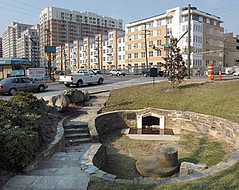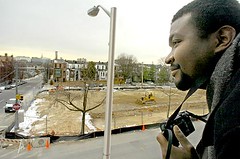TOD article, Baltimore Sun
 One of the goofy characters used in advertising promotions to promote Silver Spring.
One of the goofy characters used in advertising promotions to promote Silver Spring. I'm a bit behind in my reading and neglected two articles from last Sunday's Baltimore Sun, "Transit plans help to revitalize communities" and "Mass transit has new curb appeal: Proximity to transit attracts homebuyers to urban developments."
They cover the gamut, from what I think of TOD-oriented "urban renewal" in Silver Spring (Silver "Sprung" and Ballston to adaptive re-use and rehabilitation of historic structures in the Station North neighborhood around Penn Station in Baltimore. The latter is called urban revitalization...
Re: Silver Sprung--
"A recent weekday found Dana Hawkins-Simons and her 21-month-old daughter, Ella, window-shopping after attending their weekly Gymboree class. "We're down here all the time. There's so much to do," said Hawkins-Simons, who moved last year from Washington's Dupont Circle to a house in Silver Spring. "People kept mentioning that Silver Spring is a cool, new, hot area, and you should check it out."
 The site of the spring for which Silver Spring is named sits at a bustling intersection amid parking structures and apartment buildings.(Sun photo by David Hobby) Mar 18, 2005
The site of the spring for which Silver Spring is named sits at a bustling intersection amid parking structures and apartment buildings.(Sun photo by David Hobby) Mar 18, 2005It's interesting considering the discussion about parking policies in the District of Columbia. I think in the intermediate term things will get worse (more cars seeking the same number of places to park) until people reorient their practices and behaviors to be more positively aligned with non-automobile transportation options.
Some quotes from the article:
The idea of walk-able, mixed-use environments around public transit has been gaining traction, too, because proposed transit projects are more likely to win highly competitive federal funds if they can show how well they mesh with existing subway, light rail and commuter train systems. Federal officials also look at whether local governments encourage such development and whether developers have made commitments. The best-designed projects, experts say, promote transit ridership, reduce dependency on autos, spur creation of homes and jobs and use land resources more efficiently...
The availability of subway, light rail and commuter trains and buses has helped drive redevelopment on the city's west side, where 1,500 market-rate apartments have come online in the past few years, along with offices and shops centered on the refurbished Hippodrome Theatre.
About half the employees of businesses that have moved into the area either walk to work or take transit, said Ronald M. Kreitner, executive director of Westside Renaissance Inc. Similarly, many of the new apartment dwellers do not have cars or have just one per household, he said."The west side is the epitome of a transit-friendly growth area," Kreitner said. "We have people who work at Hopkins in East Baltimore and take the Metro. We have people who work out at BWI and take the light rail." ...
 Ernst Valery, 28, looks at the site in the 1700 block of N. Calvert St. where he has bought a yet-to-be-built townhouse be cause of its convenience to Penn Station. (Sun photo by Amy Davis)
Ernst Valery, 28, looks at the site in the 1700 block of N. Calvert St. where he has bought a yet-to-be-built townhouse be cause of its convenience to Penn Station. (Sun photo by Amy Davis) When Scott Sherman, a 38-year-old attorney, planned to move to Baltimore and commute to his job in Washington, he discovered it wasn't easy to get from trendy Canton and Locust Point to Penn Station. But Clipper Mill was just a short hop up the Jones Falls Expressway. And it had the light rail line for trips downtown."There are some cool, funky things going on by Fort McHenry and out by Canton," said Sherman, who moved into his new three-bedroom Clipper Mill townhouse last month. "But ultimately, I needed to be close to the train station."
____
I guess that the discussion about parking policies in DC has convinced me that the big new multi-unit buildings going up probably need to have as close to one parking space/unit as is possible, even though this seems counter-intuitive given my strident views about anti-automobile superiority. But this will reduce stressing the current surface street parking space inventory. I still think that transportation demand management plans must be developed to encourage alternatives to driving. Without giving it a second thought, people lean to the car, and it is impossible (and would have little impact) to increase substantively road capacity in the city.
Index Keywords: urban-revitalization; transit



0 Comments:
Post a Comment
<< Home